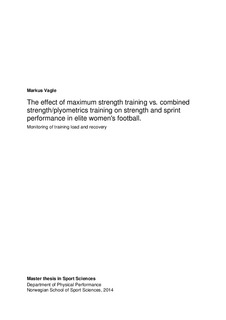| dc.description.abstract | This study consisted of two projects conducted in parallel. The aim of project I was to
investigate the effect of, and difference between, two strength-training regimes over 10-
weeks in female football players. The aim of project II was to investigate relationships
between different load monitoring techniques, level of recovery and ratings of
performance.
Eleven players from a Norwegian elite female football club was included in project I, and
ten players in project II. Participants in project I were split into two groups, plyometric
(PLY, n=6) and maximum strength (MAX, n=5). Both groups performed two strengthtraining
sessions a week for 10-weeks. MAX performed two maximum strength sessions,
and PLY performed one maximum strength session and one plyometric session. Players
was tested for 1 repetition maximum (1RM) strength in squat, bench-press and pull-down,
as well as performance in 10- and 30-m sprint, countermovement jump (CMJ) on force
platform, repeated sprint (6x30-m), Yo-yo intermittent recovery level 1 (Yoyo IR1) and
muscle architecture pre- and post to the training period. For project II, load-monitoring
data were collected through a series of methods including session rate of perceived
exertion (sRPE), pre training wellness questionnaire (PTW), neuromuscular fatigue jump
test (NMF), and coaches votes (CV).
Both groups had a substantial increase in 1RM squat (PLY = 10.4±7.1 kg effect size;
ES=0.80, MAX = 18.1±7.7 kg ES=0.80; mean ± 90% confidence limits; CL), a moderate
effect was found between groups being greater for MAX (ES = 0.85, 94% likely). MAX
showed an increase in 10-m sprint time (0.04±0.03 s, ES = 0.41, 89% likely), but no other
change was found for sprint or jump tests. A small increase in muscle thickness (PLY =
0.21±0.10 cm, MAX = 0.10±0.21 cm) was found for both groups, however the effect
between groups was considered unclear (ES = 0.26). An increase in fascicle length was
also evident (PLY = 0.60±0.89 cm, MAX 0.43±1.90 cm), but the between groups
difference was trivial and unclear (ES = 0.19). Trivial difference was found in training
load between groups throughout the period (ES = 0.17), and no consistent relationships
were evident between the load monitoring techniques.
6
Both maximum strength- and combined maximum strength and plyometric training
increases 1RM performance, but seem to have little effect on sprint and jump performance
directly. Long familiarization periods seems to be necessary in order for the load
monitoring data to be valuable and useful as a management system to assure development,
and reduce the risk of injury. | nb_NO |
